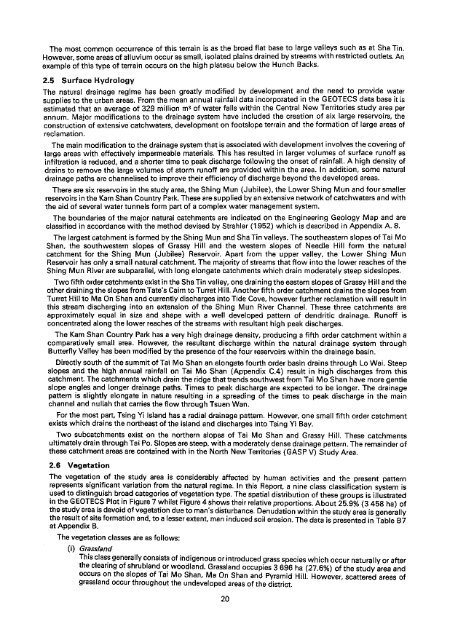m^^iz$$m&'f - HKU Libraries - The University of Hong Kong
m^^iz$$m&'f - HKU Libraries - The University of Hong Kong
m^^iz$$m&'f - HKU Libraries - The University of Hong Kong
- No tags were found...
You also want an ePaper? Increase the reach of your titles
YUMPU automatically turns print PDFs into web optimized ePapers that Google loves.
<strong>The</strong> most common occurrence <strong>of</strong> this terrain is as the broad flat base to large valleys such as at Sha Tin.However, some areas <strong>of</strong> alluvium occur as small isolated plains drained by streams with restricted outlets. Anexample <strong>of</strong> this type <strong>of</strong> terrain occurs on the high plateau below the Hunch Backs.2.5 Surface Hydrology<strong>The</strong> natural drainage regime has been greatly modified by development and the need to provide watersupplies to the urban areas. From the mean annual rainfall data incorporated in the GEOTECS data base it isestimated that an average <strong>of</strong> 329 million m$ <strong>of</strong> water falls within the Central New Territories study area perannum. Major modifications to the drainage system have included the creation <strong>of</strong> six large reservoirs, theconstruction <strong>of</strong> extensive catchwaters, development on footslope terrain and the formation <strong>of</strong> large areas <strong>of</strong>reclamation.<strong>The</strong> main modification to the drainage system that is associated with development involves the covering <strong>of</strong>large areas with effectively impermeable materials. This has resulted in larger volumes <strong>of</strong> surface run<strong>of</strong>f asinfiltration is reduced, and a shorter time to peak discharge following the onset <strong>of</strong> rainfall. A high density <strong>of</strong>drains to remove the large volumes <strong>of</strong> storm run<strong>of</strong>f are provided within the area. In addition, some naturaldrainage paths are channelised to improve their efficiency <strong>of</strong> discharge beyond the developed areas.<strong>The</strong>re are six reservoirs in the study area, the Shing Mun (Jubilee), the Lower Shing Mun and four smallerreservoirs in the Kam Shan Country Park. <strong>The</strong>se are supplied by an extensive network <strong>of</strong> catchwaters and withthe aid <strong>of</strong> several water tunnels form part <strong>of</strong> a complex water management system.<strong>The</strong> boundaries <strong>of</strong> the major natural catchments are indicated on the Engineering Geology Map and areclassified in accordance with the method devised by Strahler (1952) which is described in Appendix A. 8.<strong>The</strong> largest catchment is formed by the Shing Mun and Sha Tin valleys. <strong>The</strong> southeastern slopes <strong>of</strong> Tai MoShan, the southwestern slopes <strong>of</strong> Grassy Hill and the western slopes <strong>of</strong> Needle Hill form the naturalcatchment for the Shing Mun (Jubilee) Reservoir. Apart from the upper valley, the Lower Shing MunReservoir has only a small natural catchment. <strong>The</strong> majority <strong>of</strong> streams that flow into the lower reaches <strong>of</strong> theShing Mun River are subparallel, with long elongate catchments which drain moderately steep sideslopes.Two fifth order catchments exist in the Sha Tin valley, one draining the eastern slopes <strong>of</strong> Grassy Hill and theother draining the slopes from Tate's Cairn to Turret Hill. Another fifth order catchment drains the slopes fromTurret Hill to Ma On Shan and currently discharges into Tide Cove, however further reclamation will result inthis stream discharging into an extension <strong>of</strong> the Shing Mun River Channel. <strong>The</strong>se three catchments areapproximately equal in size and shape with a well developed pattern <strong>of</strong> dendritic drainage. Run<strong>of</strong>f isconcentrated along the lower reaches <strong>of</strong> the streams with resultant high peak discharges.<strong>The</strong> Kam Shan Country Park has a very high drainage density, producing a fifth order catchment within acomparatively small area. However, the resultant discharge within the natural drainage system throughButterfly Valley has been modified by the presence <strong>of</strong> the four reservoirs within the drainage basin.Directly south <strong>of</strong> the summit <strong>of</strong> Tai Mo Shan an elongate fourth order basin drains through Lo Wai. Steepslopes and the high annual rainfall on Tai Mo Shan (Appendix C.4) result in high discharges from thiscatchment <strong>The</strong> catchments which drain the ridge that trends southwest from Tai Mo. Shan have more gentleslope angles and longer drainage paths. Times to peak discharge are expected to be longer. <strong>The</strong> drainagepattern is slightly elongate in nature resulting in a spreading <strong>of</strong> the times to peak discharge in the mainchannel and nullah that carries the flow through Tsuen Wan.For the most part, Tsing Yi Island has a radial drainage pattern. However, one small fifth order catchmentexists which drains the northeast <strong>of</strong> the island and discharges into Tsing Yi Bay.Two subcatchments exist on the northern slopes <strong>of</strong> Tai Mo Shan and Grassy Hill. <strong>The</strong>se catchmentsultimately drain through Tai Po. Slopes are steep, with a moderately dense drainage pattern. <strong>The</strong> remainder <strong>of</strong>these catchment areas are contained with in the North New Territories (GASP V) Study Area.2.6 Vegetation<strong>The</strong> vegetation <strong>of</strong> the study area is considerably affected by human activities and the present patternrepresents significant variation from the natural regime. In this Report, a nine class classification system isused to distinguish broad categories <strong>of</strong> vegetation type. <strong>The</strong> spatial distribution <strong>of</strong> these groups is illustratedin the GEOTECS Plot in Figure? whilst Figure 4 shows their relative proportions. About 25.9% (3458 ha) <strong>of</strong>the study area is devoid <strong>of</strong> vegetation due to man's disturbance. Denudation within the study area is generallythe result <strong>of</strong> site formation and, to a lesser extent, man induced soil erosion. <strong>The</strong> data is presented in Table B7at Appendix B.<strong>The</strong> vegetation classes are as follows:(i) Grass/andThis class generally consists <strong>of</strong> indigenous or introduced grass species which occur naturally or afterthe clearing <strong>of</strong> shrubland or woodland. Grassland occupies 3 696 ha (27.6%) <strong>of</strong> the study area andoccurs on the slopes <strong>of</strong> Tai Mo Shan, Ma On Shan and Pyramid Hill. However, scattered areas <strong>of</strong>grassland occur throughout the undeveloped areas <strong>of</strong> the district.20

















